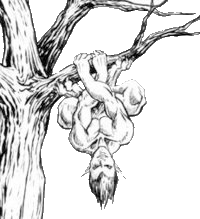 |

|
|
HINDU SPIRIT WORLD
Hindu mythology defines fourteen
worlds, seven higher worlds (heavens)
and seven lower ones (hells). The earth
is considered the lowest of the seven
higher worlds so it is pretty much in
the middle.
All the worlds except the earth are used as temporary
places of stay as follows: upon one's death on earth,
Yama, the god of death tallies the person's good/bad
deeds while on earth and decides if the soul goes to heaven
and/or hell, for how long, and in what capacity. Some
versions of the mythology state that good and bad deeds
neutralize each other and the soul therefore spends time in
either a heaven or a hell, but not both, whereas according
to another school of thought, the good and bad deeds don't
cancel out each other. In either case, the soul acquires a
body as appropriate to the worlds it is entering.
At the end of the soul's time in those worlds, it returns
to the earth (is reborn as a life form on the earth). It is
considered that only from the earth, and only after a human
life, can the soul reach supreme salvation Moksha, the state
free from the cycle of birth and death and the place beyond
the fourteen worlds where the eternal god lives. |

WORLD RELIGIONS
COMPARED
WORLD
RELIGIONS CLIPART
WORLD
RELIGIONS HOME
HINDUISM HOME |
Swarga is the third among the seven higher
worlds. In common usage, Swarga is used to refer to the 'higher
worlds' or heavens in general.
The higher worlds (except the earth) are populated with a variety of
beings called Suras, consisting of several sub-divisions:
Deva, Dhanava, Gandharva, Yaksha, Kinnara, and so on. In general,
beings of a higher heavenly world can freely visit a lower one.
All the posts (kings, etc.) in the heavenly worlds are awarded based
on the good deeds one performs while on earth.
The term Naraka indicates the various lower worlds. The lower
worlds are filled with Asuras and many other types of demons
and giants.
Suras and Asuras can inspire or bring down
aspirants, helping or hindering people's spiritual journey.
 |
ASURAS (DEMONS / GIANTS):
Asura, meaning lifeless; in other words, not in tune
with the infinite.
|
 |
SURAS (DEVTA / ANGELS): The
Hindus call the angels Suras; Sura also means breath and
breath means life. Suras, therefore, mean pure lives,
lives that live long.
|
Most of the gods we
know can be sorted into gods, demi gods, lesser gods, asuras, devas,
rishis and the super gods. Buddha and Mahavira are more of saints
than proclaimed gods.
The hierarchy starts with us humans being, the lesser mortals at the
bottom, higher up are the lesser gods who are the gandharvas,
kinnaras, vidhyadharas and apsaras. Their lords are the yakshis and
yakshas - fertility goddesses and nature gods. Shalabhanjikas are
fertility goddesses often depicted against trees with one leg bent
up and one hand holding a branch. They are believed to be virgins
who were capable of making a tree bear flower.
Nagas have a similar standing on this plain. Snakes are associated
with water, the underground, and fertility. They were adopted into
Hinduism as emblems of Shiva (perhaps reflecting Shiva's own origins
from earlier nature cult), and were adopted into Buddhism as
protectors of Buddha.
Above them are the rishis, devas, and demi gods etc who would be
weather gods and their sons. Ganesha, the proclaimed son of Lord
Shiva is the lord of the Ganas . Finally we have the super gods like
Shiva, Vishnu, Brahma and to a certain extent the Mother Goddess.
All gods have vehicles or vahanas and various hybrid creatures like
griffins scattered through out the pantheon.
Lead me from the unreal to the
Real.
Lead me from darkness to Light.
Lead me from death to Immortality..
The Upanishads

| |
 |
 |

